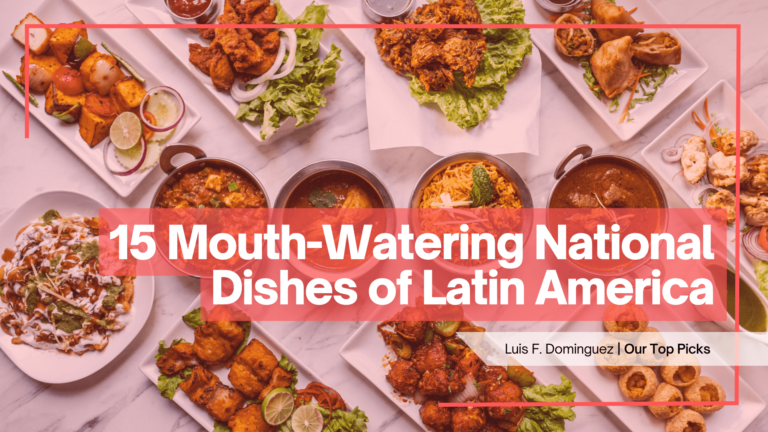National dishes from Latin America are fascinating, colorful, and yes—spicy!
From Mexican mole and Argentinian asado to Peruvian ceviche and Salvadoran pupusas, learn all about the many delicious creations of Latin American gastronomic creativity.
In this list, discover 15 most delicious national dishes of Latin America.
Join 559 million people on the planet who speak Spanish!
Sign up for your free trial Spanish class today. 


Table of Contents:
- Kaleidoscope of Cultural Cuisines
- 15 Mouth-Watering, Delicious National Dishes of Latin America
- Learn About Latin America National Dishes and Improve Your Spanish
Kaleidoscope of Cultural Cuisines
Latin American culture—a controversial concept in itself—is an amazing kaleidoscope of diverse cultural expressions of 20 countries, from Mexico in the north to the Chilean Tierra del Fuego in the south, including some (but not all) Caribbean islands.
If we accept that there’s such a thing as Latin American culture, then there should be a Latin American cuisine, right?
Well, it’s not that simple.
Latin American people love their food and feel proud of it. But there are often great differences between one national cuisine and the next. For this reason, Latin American cuisine is actually an aggregate of various national dishes.
Let’s explore them!
15 Mouth-Watering, Delicious National Dishes of Latin America
Check out these 15 delicious gastronomic creations produced by the endless imagination of Latin American chefs, cooks, and abuelitas (grandmas).
1. Mexico – Mole
Mexico’s cuisine was the first to be declared Intangible Heritage of Humanity by UNESCO.
Although tacos may be its most famous dish, another culinary specialty is the national dish of Mexico: mole!
Mole is “the generic name given to an array of different sauces of diverse colors.” However these sauces aren’t your typical sauce that you pour over your tacos.
It’s a more refined sauce that sometimes includes chocolate! It often accompanies a main dish like chicken with rice, for instance.
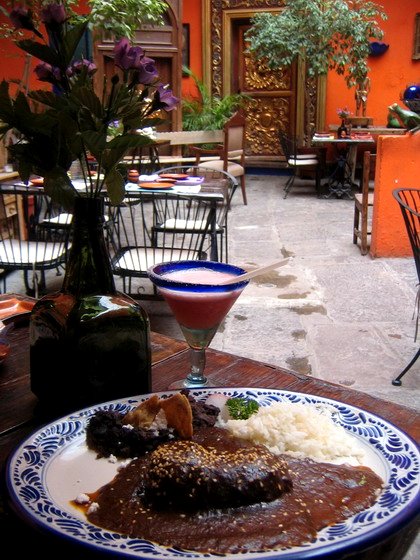
Ingredients
| English | Spanish |
| ancho chile | el chile ancho |
| chicken | el pollo |
| clove | el clavo |
| dark chocolate | el chocolate oscuro |
| garlic | el ajo |
| lard | la manteca |
| mulato chile | el chile mulato |
| onion | la cebolla |
| pasilla chile | el chile pasilla |
| peanuts | los cacahuates / el maní |
| salt | la sal |
| sesame | el ajonjolí |
| sugar | el azúcar |
| tomatoes | los tomates |
2. Peru – Ceviche
Peruvian cuisine is enjoying an international boom. It’s one of the most recognized Latin American cuisines in the world.
It’s also the cuisine with the largest number of dishes in the world. The most famous Peruvian export is ceviche (or cebiche).
This Latin American gastronomic classic includes raw fish, a mix of citrus juices, and a selection of vegetables. An apparently simple dish, it produces extraordinarily complex flavors and tastes.
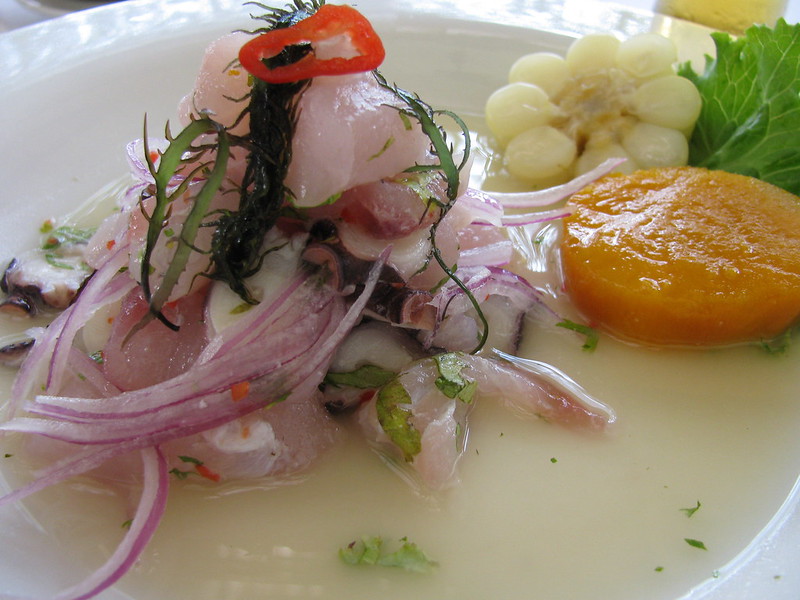
Ingredients
| English | Spanish |
| coriander | el cilantro |
| ginger | el jengibre |
| habanero red pepper | el chile habanero rojo |
| lemon | el limón |
| lime | la lima |
| mahi-mahi | el mahi mahi |
| plantain chips | los chips de plátano |
| purple onion | la cebolla morada |
| salt | la sal |
| sweet potatoes | las batatas dulces |
| yellow corn | el maíz amarillo |
3. Venezuela – Pabellón Criollo
Just like with Mexican tacos, Venezuelan arepas may be this South American country’s most famous food, but they aren’t its national dish. That honor belongs to the exquisite pabellón criollo.
A combination of traditional Venezuelan rice, meat, and beans is arranged on the plate representing the Venezuelan part. (Just don’t ask Venezuelan people where the blue color from their flag is on the plate.)
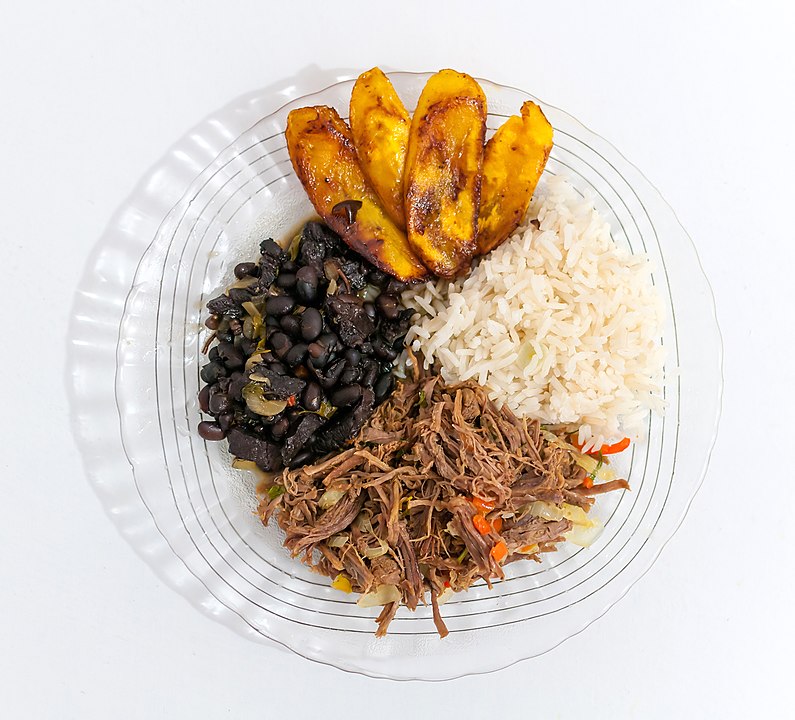
Ingredients
| English | Spanish |
| rice | el arroz |
| plantains | los plátanos machos |
| black beans | los frijoles negros |
| garlic | el ajo |
| onion | la cebolla |
| cumin | el comino |
| salt | la sal |
| sugar | el azúcar |
| bacon | el tocino |
| flank steak | la falda de res |
| carrots | las zanahorias |
| tomatoes | los tomates |
| oregano | el orégano |
| celery | el apio |
4. Argentina – Asado
If you think you’re passionate about barbecues, Argentinian people have taken this passion to a whole different level. In Argentina, the asado is much more than a simple barbecue, it’s a way of life. Their entire cuisine revolves around this protein-rich dish.
Although asado is basically a barbecued steak, the way Argentinians prepare it makes it a unique dish.
First, there’s a special technique in the way the steak should be grilled, but to make a real asado argentino, you need to accompany the steak with chimichurri, potatoes, and white bread, among other ingredients.
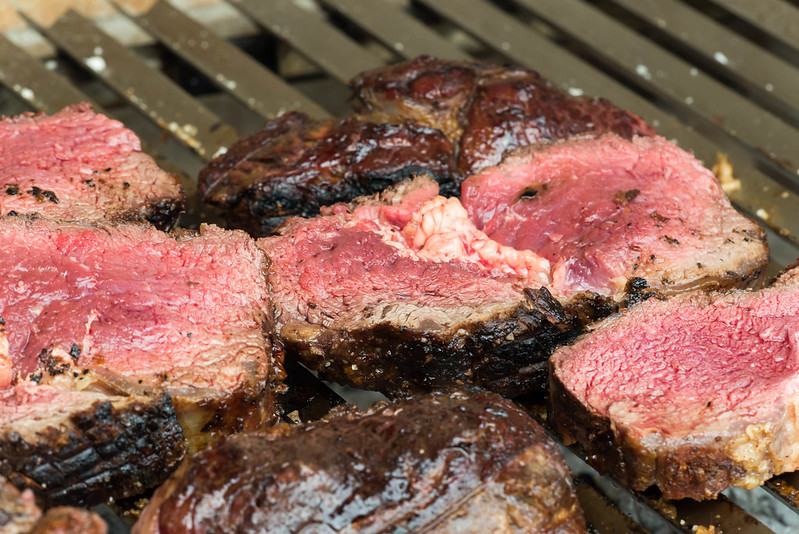
Ingredients
| English | Spanish |
| beef | la carne de res |
| chimichurri | el chimichurri |
| chinchulines | los chinchulines |
| chorizo sausages | el chorizo |
| lemon | el limón |
| lettuce | la lechuga |
| potatoes | las papas |
| tomatoes | los tomates |
| white bread | el pan blanco |
5. Cuba: Ropa Vieja
Cuba’s national dish literally translates as “old clothes” and legend has it that it got its name from a “penniless old man” who once cooked his own clothes while praying. Miraculously, the shredded clothes became a tasty meat stew.
Originally from Spain, ropa vieja traveled to the Americas centuries ago and quickly became a staple of Cuban gastronomy. This delicious dish of slow-cooked beef mixed with olives, tomatoes, and other vegetables is a must next time you visit Cuba.
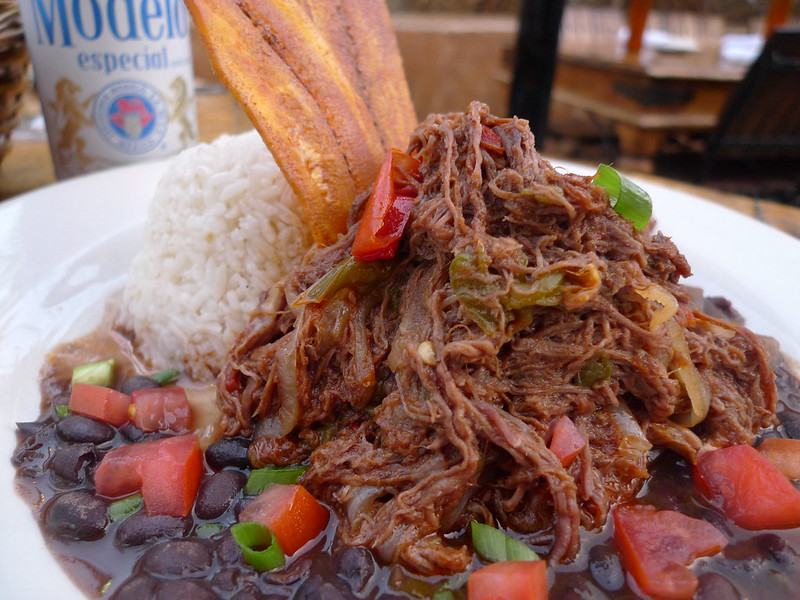
Ingredients
| English | Spanish |
| beef | la carne de res |
| bell peppers | los pimientos |
| capers | las alcaparras |
| chicken broth | el caldo de pollo |
| clove | el clavo |
| cumin | el comino |
| garlic | el ajo |
| olives | las aceitunas |
| onion | la cebolla |
| oregano | el orégano |
| paprika | el pimentón |
| tomato paste | la pasta de tomate |
6. Guatemala: Pepian
Guatemala cuisine is heavily influenced by its strong Mayan heritage, as the Maya-Kaqchikel ethnic group originally made pepian. The dish is similar to the Mexican mole, a dense sauce with a fascinating mix of ingredients and flavors, poured over meats and accompanied by rice and vegetables.
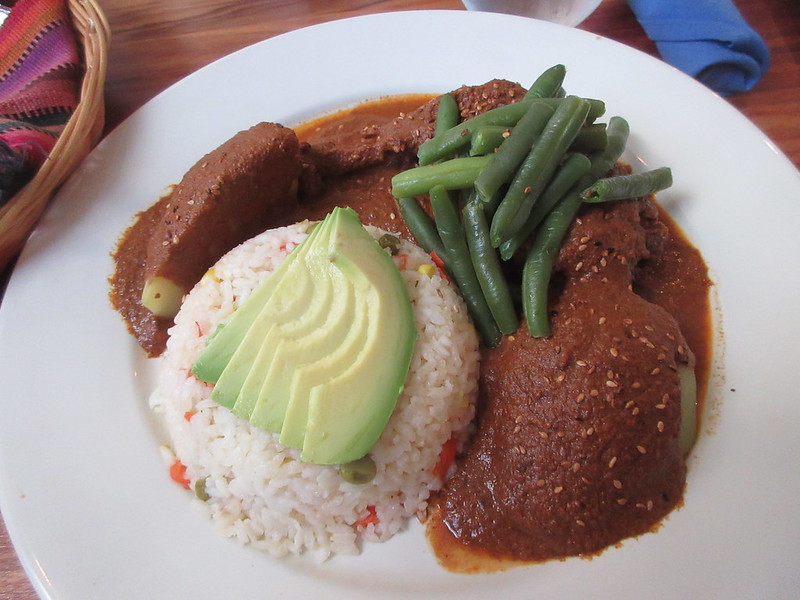
Ingredients
| English | Spanish |
| allspice berries | las bayas de pimienta |
| black peppercorns | los granos de pimienta negros |
| chicken stock | el caldo de pollo |
| cinnamon sticks | los ramitos de canela |
| clove | el clavo |
| coriander seeds | las semillas de cilantro |
| cornflour | la harina de maíz |
| guisquil | el guisquil |
| onion | la cebolla |
| oregano | el orégano |
| potatoes | las papas |
| pumpkin seeds | las semillas de calabaza |
| sesame seeds | el ajonjolí |
| tomatoes | los tomates |
7. Dominican Republic: La Bandera
This proud representative of Caribbean cuisine literally means “the flag,” as it represents the Dominican Republic flag. The meat represents the blue, the rice represents the white, and the red beans the red color in the flag.
This delicious dish is usually served with a Dominican salad and a side dish, and sometimes it’s even presented to look like the actual Dominican flag.
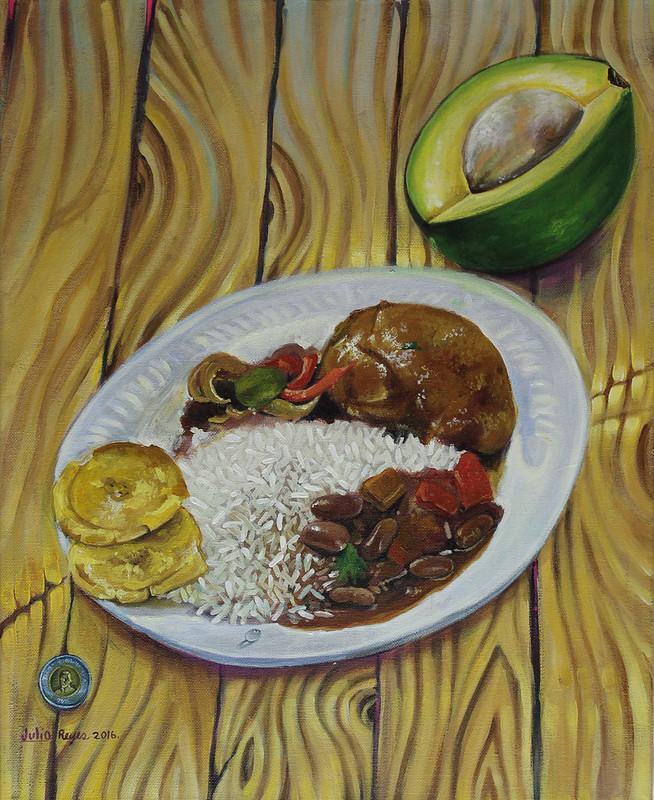
Ingredients
| English | Spanish |
| adobo seasoning | el adobo |
| beef | la carne de res |
| garlic | el ajo |
| oregano | el orégano |
| parsley | el perejil |
| pepper | la pimienta |
| plantains | los plátanos machos |
| red beans | los frijoles rojos |
| red onion | la cebolla morada |
| rice | el arroz |
| Worcestershire sauce | la salsa Worcestershire |
8. Colombia: Bandeja Paisa
The Colombian government named Colombia’s national dish in 2005. The decision was surrounded by controversy as Paisa refers to a northwestern region of the country called Antioquia, and some people felt the national dish should include the whole country.
This dish is full of animal protein and Colombians like it in large portions, so try it when hungry. It’s usually served in an oval plate and it includes fried pork, minced meat, chorizo, arepas, fried eggs, and avocado.
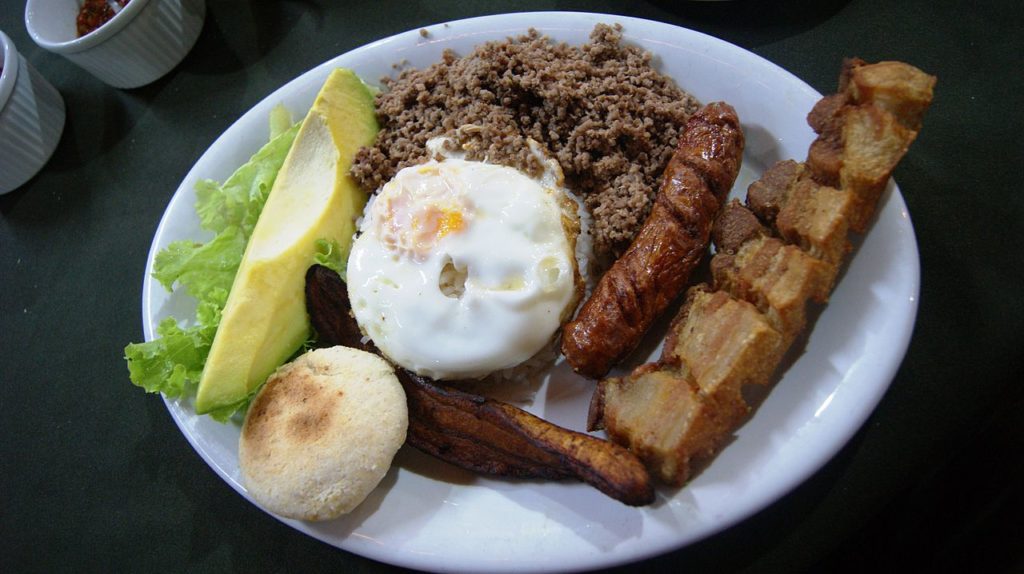
Ingredients
| English | Spanish |
| arepas | las arepas |
| avocado | el aguacate |
| chicharron | el chicharrón |
| chorizo | el chorizo |
| cumin | el comino |
| fried eggs | los huevos fritos |
| hogao | el hogao |
| minced meat | la carne molida |
| rice | el arroz |
| salt | la sal |
| skinless pork belly | la panceta de cerdo sin piel |
| sugar | el azúcar |
9. Ecuador: Cuy Asado
Ecuador doesn’t have a defined national dish like other Latin American countries. Some sources consider ceviche to be the national dish, others mention encebollado.
Still others choose the cuy asado. A cuy is a guinea pig, and asado means grilled. Meaning that you’ll be eating a grilled guinea pig. But don’t let prejudice take over your gastronomy adventures and try this dish with an open mind and, preferably, an empty stomach.
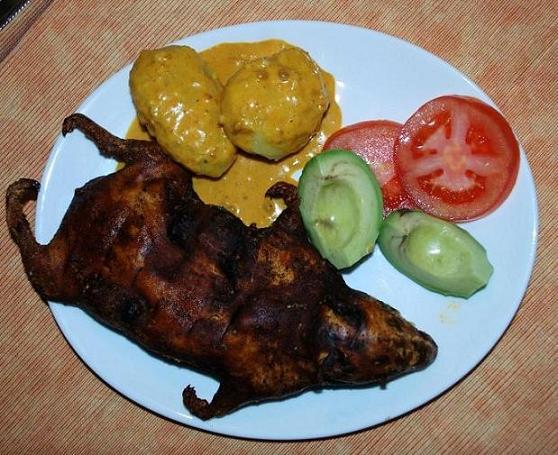
Ingredients
| English | Spanish |
| coriander | el cilantro |
| cumin | el comino |
| garlic | el ajo |
| Guinea pig | el cuy |
| lemon | el limón |
| onion | la cebolla |
| pepper | la pimienta |
| potatoes | las papas |
| rice | el arroz |
| salt | la sal |
| sugar | el azúcar |
| tomatoes | los tomates |
10. Honduras: Plato típico
Literally meaning “traditional dish,” the Honduran plato típico is a tasty mix of grilled meat, pork sausages, beans, fried plantain, and rice. Enjoy it with corn flour tortillas, avocado, and fresh cheese.
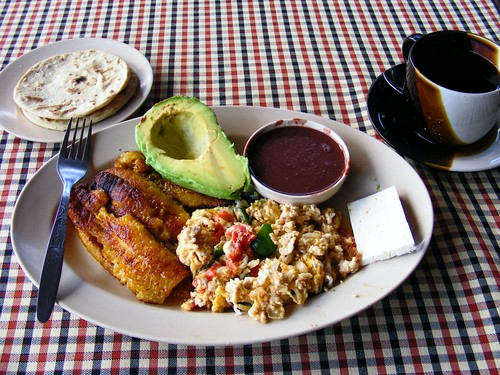
Ingredients
| English | Spanish |
| avocado | el aguacate |
| chismol | el chismol |
| fresh cheese | el queso fresco |
| grilled meat | el cilantro |
| pork sausages | el comino |
| rice | el arroz |
| stewed beans | el ajo |
11. Uruguay: Chivito
Chivito literally means “little goat” but in Uruguay it actually is a delicious steak sandwich. Although the beef steak is the main ingredient, the beauty about chivito is that it can include many more things such as egg, bacon, and melted cheese.
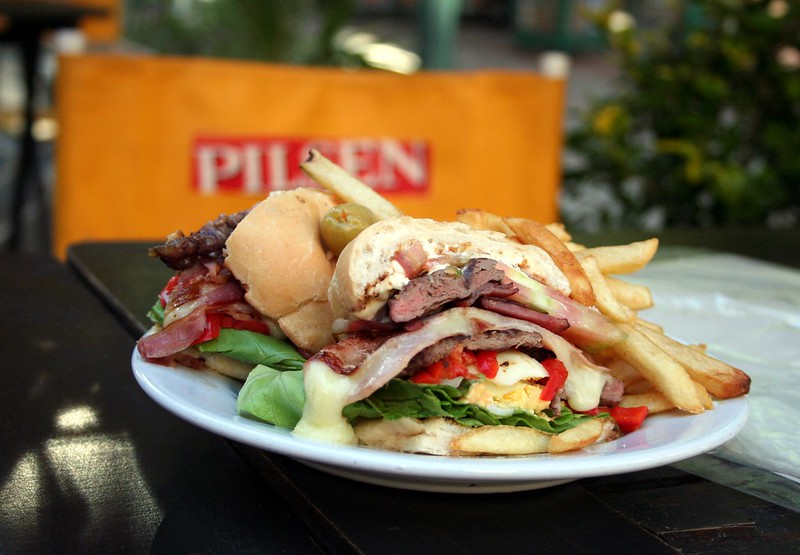
Ingredients
| English | Spanish |
| bacon | el tocino |
| fried egg | el huevo frito |
| lettuce | la lechuga |
| mayonnaise | la mayonesa |
| mozzarella | la mozzarella |
| olives | las aceitunas |
| steak | la carne de res |
| tomatoes | los tomates |
| white bread | el pan blanco |
12. Costa Rica: Gallo Pinto
Although gallo pinto means “spotted rooster,” you won’t be eating any rooster when ordering this dish in Costa Rica. One of the few countries whose national dish is a breakfast food, as basically it’s a combination of beans and rice.
A funny thing about gallo pinto is that Nicaraguans also consider it their national dish and they engaged in a Guinness Book of Records with Costa Rica to see which country could cook the most gallo pinto.
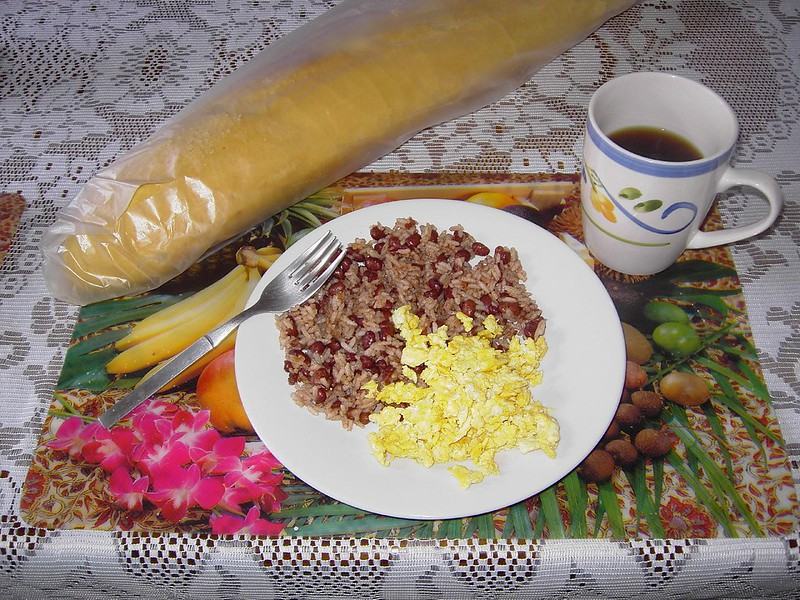
Ingredients
| English | Spanish |
| black beans | los frijoles negros |
| coriander | el cilantro |
| onion | la cebolla |
| red pepper | el pimiento rojo |
| chicken broth | el caldo de pollo |
| white rice | el arroz blanco |
| salt | la sal |
| vegetable oil | el aceite vegetal |
13. Brazil: Feijoada
The name of Brazil’s national dish comes from the Portuguese feijão which means “bean,” as feijoada is an exquisite black bean stew enriched with smoked pork or beef and served with rice, vegetables, and orange slices.
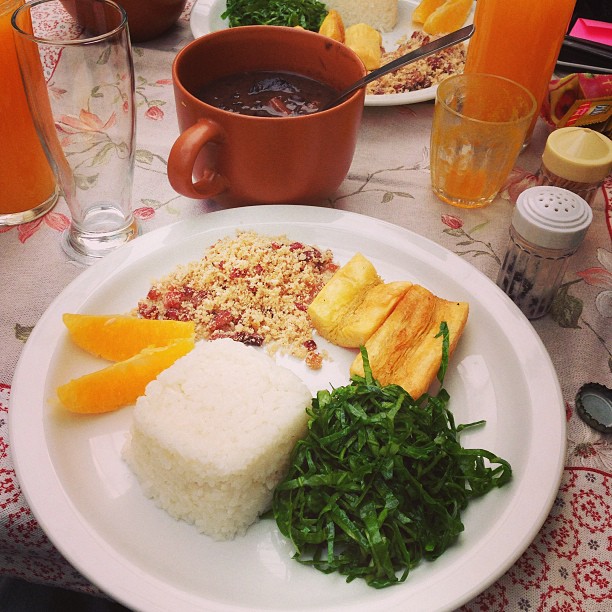
Ingredients
| English | Spanish |
| smoked bacon | el tocino ahumado |
| bone-in pork shoulder | el hombro de puerco con hueso |
| onion | la cebolla |
| garlic | el ajo |
| dried black beans | los frijoles negros secos |
| smoke ham | el jamón ahumado |
| bay leaves | las hojas de laurel |
| black pepper | la pimienta negra |
| cooked rice | el arroz cocido |
| sliced orange | la naranja en rodajas |
14. El Salvador: Pupusas
Pupusas are an essential part of the fascinating tortilla culture that spreads across Latin America.
Although they look like tortillas, they’re actually filled with hot cheese and beans or other ingredients. The word pupusa comes from pupusawa, which means to puff up or to inflate in the ancient Náhuatl language spoken by the indigenous people of El Salvador.
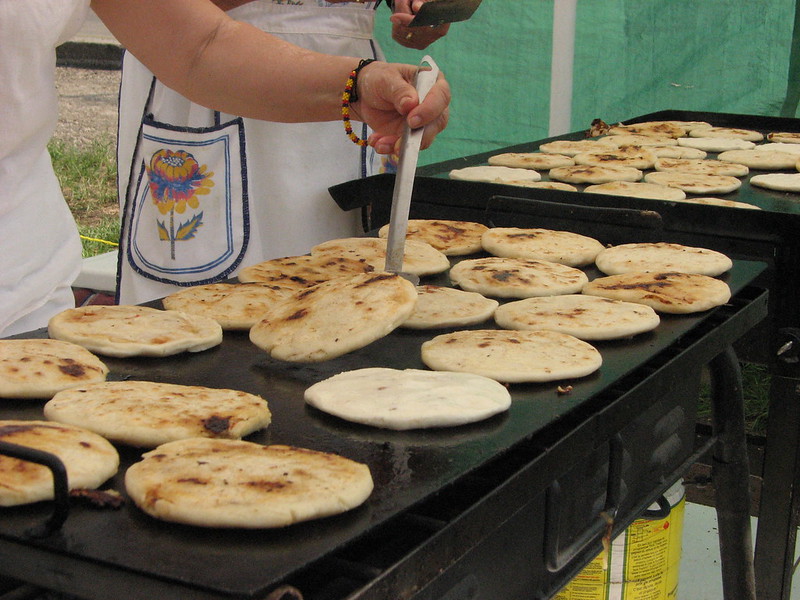
Ingredients
| English | Spanish |
| beans | los frijoles |
| cabbage | el repollo |
| cheese | el queso |
| cornmeal flour | la masa harina |
| fried pork belly | el chicharrón |
15. Paraguay: Sopa paraguaya
Even though sopa paraguaya means “Paraguayan soup,” this South American country’s national dish isn’t actually a soup. It’s a moist cornbread casserole you eat with a roast, chili, or stew.

Ingredients
| English | Spanish |
| cassava root | la yuca |
| chicken | el pollo |
| corn | el maíz |
| garlic | el ajo |
| onion | la cebolla |
| plantain | el plátano |
| potatoes | las papas |
| salt | la sal |
Learn About Latin America National Dishes and Improve Your Spanish
These are some of the most delicious dishes in Latin America, a region famous around the world for its extraordinary gastronomy. Learn about these national dishes—perhaps find a restaurant that serves them or even make them in your own kitchen—and improve your Spanish food vocabulary!
One of the main benefits of speaking Spanish is that it makes it easier for you to travel to Spanish-speaking countries. Next time you visit Latin America, make sure to try one or more of these dishes. You won’t be disappointed!
Sign up today for a free trial class at Homeschool Spanish Academy with one of our certified, native-speaking teachers from Guatemala. They teach over 24,000 actively enrolled students every month and offer flexible scheduling, and tailored Spanish programs.


Join one of the 40,000 classes that we teach each month and you can experience results like these

“This is the best way for your kid to learn Spanish. It’s one-on-one, taught by native Spanish speakers, and uses a curriculum.”
– Sharon K, Parent of 3

“It’s a great way to learn Spanish, from native Spanish speakers in a 1-on-1 environment. It’s been fairly easy to schedule classes around my daughter’s other classes. The best value for us has been ordering multiple classes at a time. All the instructors have been great!”
– Cindy D, Parent of 3

“HSA offers very affordable, quality, one on one classes with a native speaker. My son has greatly benefited from taking classes. We have seen his confidence increase as well as his pronunciation improve, because he learns from a native Spanish speaker. HSA has quick, personal customer service. Our family has been very pleased with our experience so far!”
– Erica P. Parent of 1
Want to learn more about Latin American culture? Check out our latest posts!
- 15 Mouth-Watering National Dishes of Latin America
- 60 Best New Year Quotes in Spanish 2024
- The End of the Year Vacation Guide 2023 You Were Looking For
- Top Productivity Apps to Try For Language Learning
- 5 Educational Video Games to Practice Spanish
- Top 10 Hispanic Museums to Visit
- Best Tablets For Kids 2023 Edition
- Top 7 Countries to Study Abroad in Latin America
The post 15 Mouth-Watering National Dishes of Latin America appeared first on Homeschool Spanish Academy.


